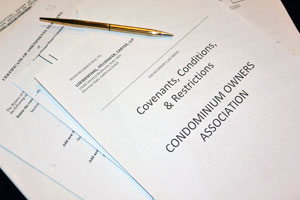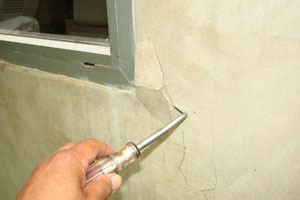(“What Do You Mean I Can’t Smoke Pot at the Community Pool?”)
So we finally have an understanding of the law relating to cigarette smoking in community associations. However, perhaps the secondhand smoke issues are not as clear as we think. Imagine this scenario, a few years from now, on a warm summer’s day at the community pool area at your condo association: a heavy fog of marijuana smoke wafts from a group of teenagers, lounging next to parents trying to enjoy the sun with their small children. After a painful coughing fit, an elderly man approaches the teens and asks them politely to stop smoking at the pool because of his emphysema. A teen in a tie-dye shirt responds, “no way man- we have California medical marijuana cards–just go away”. After coughing some more, the old man returns to his condo, frightened to ever venture out near the pool area again.
Sure, that’s an extreme example, but what does California law have to say about the use of medical marijuana in community association settings? Surprisingly, very little. Can a patient smoke pot in common areas? Can a member grow marijuana on his balcony or patio? Does a little plastic identification card trump the rights to quiet enjoyment of the membership as a whole? If you look to state law for definitive answers, you’re not going to find them.
In 1996, California enacted Proposition 215, known as the Compassionate Use Act, authorizing medical prescriptions / recommendations to persons who suffer from various specified conditions “or any other illness for which marijuana provides relief”. Since then, the state has enacted Senate Bill 420 and other laws confirming the limited right of Californians to cultivate and use marijuana pursuant to a medical recommendation.
Though the cultivation and use of marijuana remain criminal offenses under Federal Law, community associations are forced to deal with the ambiguities and potential nuisances flowing from the California medical marijuana laws. However, a careful analysis of the current state of the law shows that marijuana growing and use can generally be kept within the confines of the patient’s home or unit if an association takes the appropriate actions with its governing documents and enforcement procedures.
SIMILARITIES WITH RESTRICTIONS LIMITING CIGARETTE SMOKING
For the most part, smoking medical marijuana can be limited in much the same way as cigarette smoking. If cigarettes, for example, are allowed on patios or outdoor common areas, marijuana smoking by legal patients must probably be allowed as well. If your association does not allow smoking on balconies, patios, or common areas, then marijuana smoking can similarly be prohibited. Technically, such restrictions, pursuant to an association’s governing documents, can apply to common areas and exclusive use common areas. The rationales justifying limitations on cigarette smoking should equally apply to marijuana. Such restrictions are best carried out by way of CC&R amendments and, to a less certain degree, specific association rules and regulations. Careful attention, however, should be paid to the specific wording of such amendments and restrictions.
CAN YOU PROHIBIT MEDICAL MARIJUANA WITHIN A MEMBER’S HOME OR UNIT?
While enforceability of CC&R provisions attempting to completely ban cigarette smoking, including within members’ separate interest units, is both questionable and controversial, a few associations in various states have attempted to do so. Can the use of medical marijuana likewise be entirely
banned? In a word, the answer is “no”.
Health & Safety Code §11362.79 specifies places where medical marijuana cannot be used, including any place where smoking is prohibited by law, in a motor vehicle, and within 1000 feet of a school recreation center or youth center. However, it can be implied that this same section allows use of medical marijuana in a patient’s home. If an association attempted to prohibit the use of marijuana within the member’s residence, it would directly conflict with the intent behind the statutory scheme.
Thus, to the extent that the growing and use of medical marijuana does not constitute a “nuisance,” it would likely be unreasonable to refuse to allow a member to do so within the confines of his or her house or unit. This is true even in situations where the association’s governing documents do not allow cigarette smoking within residences.
WHAT TO DO WHEN SECONDHAND SMOKE OR ODORS BECOME A NUISANCE TO OTHER MEMBERS?
A nuisance occurs when conduct unreasonably interferes with the use and enjoyment of other members. The legal standard asks whether the gravity of the harm objectively outweighs the social utility of the offending conduct. To constitute a nuisance, the invasion of an owner’s interest in the use and enjoyment of his or her home must be substantial, based on proof of significant harm judged by an objective standard. The CC&R’s of most associations already contain fairly standard nuisance provisions.
Where marijuana fumes and secondhand smoke make their way outdoors or into the homes of other members or residents, there is a strong argument in favor of a nuisance finding. As with offending cigarette smoke, a formal hearing should be noticed with the offending member as part of the association’s investigation. If the Board of Directors objectively determines that the medical marijuana use constitutes a nuisance, the offending member may be required to take steps, as appropriate, to abate the nuisance. Such steps may include, but are not necessarily limited to, requiring the installation of HEPA filters, weather stripping, door sweeps, closing of doors and windows, and/or the sealing of any penetrations that allow smoke and odors to travel where they are unwanted. Costs associated with abating the nuisance should be borne by the offending member.
An alternative approach, as with other nuisances, involves judicial enforcement (request for resolution, mediation, and ultimately formal litigation, where necessary). We recommend seeking the advice of legal counsel where judicial enforcement is desired.
MUST “REASONABLE ACCOMMODATIONS” BE MADE TO A MEDICAL MARIJUANA PATIENT?
If medical marijuana use is based on a legal prescription from a medical professional for a physical or mental disability, does the Fair Employment and Housing Act (“FEHA”) require associations to make “reasonable accommodations” to allow for the growing and use of marijuana?
Though there is no California case directly addressing this issue, the Supreme Court has answered a similar question in connection with employer / employee relations. In Ross v. RagingWire Telecommunications, Inc., the Supreme Court held that the FEHA does not require employers to accommodate the use of an illegal drug and that no reasonable accommodation is required at the workplace for medical marijuana users. By analogy, a community association should not be required to provide accommodations to facilitate the growing or use of marijuana to a registered patient. Thus, while an association cannot completely prohibit a patient’s right to grow or use medical marijuana, it does not have to provide special accommodations for such uses. member or resident has specific rights under California law. It is not likely that the courts would look favorably on an association’s demands for additional personal information, including documentation confirming a patient’s underlying illness or condition.
CAN AN ASSOCIATION DEMAND PROOF OF A PATIENT’S MARIJUANA PRESCRIPTION AND UNDERLYING ILLNESS OR DISABILITY?
While an association must have the general right to see evidence of a patient’s medical marijuana recommendation, requesting additional information or documentation will likely be viewed as unreasonable and discriminatory. A valid medical recommendation or prescription establishes that a member or resident has specific rights under California law. It is not likely that the courts would look favorably on an association’s demands for additional personal information, including documentation confirming a patient’s underlying illness or condition.
CONCLUSION
With the acknowledged conflicts between Federal and California law regarding medical marijuana, it cannot be known what the state of the law will be when all of the “smoke” eventually settles. For the time being, we know that a patient has the limited right to grow or use medical marijuana in his or her home pursuant to state laws. However, we also know that right does not trump the right of the other association residents to quiet enjoyment of their homes and community without intrusion by unreasonable nuisances caused by others.
As first published in the Fourth Quarter 2012 issue of the Channel Islands Chapter of Community Associations Institute magazine Channels of Communication.
2013 by Loewenthal, Hillshafer & Carter, LLP. All rights reserved. Permission is granted to reproduce or transmit in any form any part of this newsletter as long as proper attribution to Loewenthal, Hillshafer & Carter, LLP is given. Due to the rapidly changing nature of the law, information contained in this publication may become outdated. As a result, lawyers and all others using this material must research original sources of authority.


